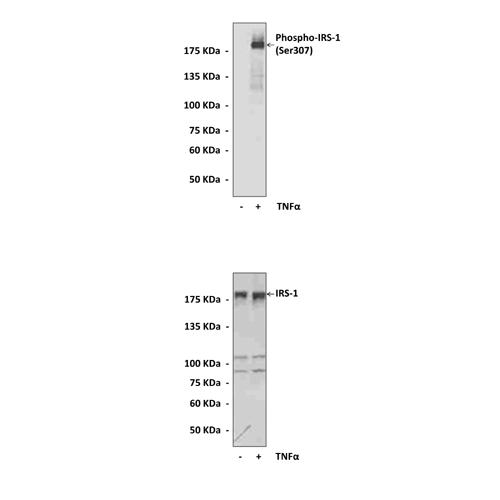Anti-Phospho-IRS-1: Polyclonal Insulin Receptor Substrate, Phospho-Ser307 Antibody |
 |
BACKGROUND Insulin receptor substrate (IRS) proteins play a central role in maintaining basic cellular functions such as growth and metabolism. IRS proteins act as an interface between multiple growth factor receptors possessing tyrosine kinase activity, such as the insulin receptor, and a complex network of intracellular signaling molecules containing Src homology 2 (SH2) domains. Four members (IRS-1, IRS-2, IRS-3, IRS-4) of this family have been identified which differ in their subcellular distribution and interaction with SH2 domain proteins.1 Insulin receptor substrate-1 (IRS-1) is a major substrate of insulin and insulin-like growth factor-I receptors. The activated insulin receptor phosphorylates the intracellular substrate IRS-1, which then binds various signaling molecules that contain SH2 domains, thereby propagating the insulin signal. Among these IRS-1-binding proteins, the Grb2-Sos complex and the protein tyrosine phosphatase SHP-2 transmit mitogenic signals through the activation of Ras, and phosphoinositide 3-kinase is implicated in the major metabolic actions of insulin.2 Insulin also activates several kinases that induce the phosphorylation of IRS-1 on specific serine/ threonine sites and inhibit its functions. This is part of the negative-feedback control mechanism induced by insulin that leads to termination of its action.3 Agents which induce insulin resistance, such as free fatty acids, cytokines, angiotensin II, endothelin-1, amino acids, cellular stress and hyperinsulinemia, also lead to activation of several serine/threonine kinases and phosphorylation of IRS-1. These agents negatively regulate IRS-1 function by phosphorylation and other molecular mechanisms (SOCS expression, IRS degradation, O-linked glycosylation).4 IRS-1 mediates the control of various cellular processes by insulin. Serine hyperphosphorylation of IRS1 may lead to insulin resistance. Ser307 in rat IRS-1 or Ser312 in human IRS-1 is phosphorylated via several mechanisms, including insulin-stimulated kinases or stress-activated kinases like JNK1.5
REFERENCES
1. Yenush, L. & White, M.F.: Bioessays 19:491, 1997.
2. Ogawa, W., Matozaki, T., & Kasuga, M.: Mol. Cell. Biochem. 182:13, 1998.
3. Sesti, G.: Best Pract Res Clin Endocrinol Metab. 20:665, 2006.
4. Gual, P. et al.: Biochimie 87:99, 2005.
5. Aqurrie, V. et al: J. Biol. Chem. 277:1531-7, 2002.
2. Ogawa, W., Matozaki, T., & Kasuga, M.: Mol. Cell. Biochem. 182:13, 1998.
3. Sesti, G.: Best Pract Res Clin Endocrinol Metab. 20:665, 2006.
4. Gual, P. et al.: Biochimie 87:99, 2005.
5. Aqurrie, V. et al: J. Biol. Chem. 277:1531-7, 2002.
Products are for research use only. They are not intended for human, animal, or diagnostic applications.
Параметры
Cat.No.: | CC1032 |
Antigen: | sequence surrounding & including Ser307 of human IRS-1. |
Isotype: | Affinity Purified Rabbit IgG |
Species & predicted species cross- reactivity ( ): | Human, Mouse, Rat |
Applications & Suggested starting dilutions: | WB 1:1000 IP n/d IHC (Paraffin) n/d ICC n/d FACS n/d |
Predicted Molecular Weight of protein: | 180 kDa |
Specificity/Sensitivity: | This antibody detects endogenous Phospho-IRS-1 in cell lysates. |
Storage: | Store at 4° C for frequent use; at -20° C for at least one year. |
*Optimal working dilutions must be determined by end user.
Документы
Информация представлена исключительно в ознакомительных целях и ни при каких условиях не является публичной офертой








